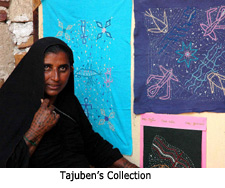
Crafts, Handlooms, Art, Craftspersons/ Artisanal, Education/Learning
Crafting Rabari Lives
Frater, Judy
March, 2008
When I wrote both chapters in Threads and Voices I took this as an opportunity to explore the artisans’ sense of design – in preparation for beginning Kala Raksha Vidhyalaya (KRV). The experience was truly enlightening. What I would like to do is review what I learned, and bring us up to date in light of two and a half years of Kala Raksha Vidhyalaya.
Background for KRV
When thinking about Rabari embroidery, there are two points to stress: First, Rabari embroidery is a living tradition—still being practiced for its original purpose, in addition to being done for sale
Second, Rabari embroidery is an ART. While some crafts were always professional, Rabari and other Kutchi women’s embroidery were not. We can not underestimate the change of concept required to turn art to commerce.
From Art to Commerce
People would like to see the kind of work done traditionally for sale now—and at cheap rates. The solution is production line work- artisans working on block printed patterns—which is how professional work in other regions is done.
Many people feel that production line work is “improved” in addition to being cheaper!
From the art point of view, in production line work the personal, human quality is sort of airbrushed out. But the more critical factor is that with production methods the value of hand work is greatly diminished. In addition, there is the issue of creativity, which is a critical aspect of ART. I tried to bring out the artisans’ feelings about the satisfaction of creativity in my article....
This is a preview. To access all the essays on the Global InCH Journal a modest subscription cost is being levied to cover costs of hosting, editing, peer reviewing etc. To subscribe, Click Here.



